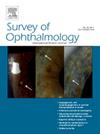Nociplastic pain among individuals with chronic ocular surface pain: One cause for “pain without stain”?
IF 5.1
2区 医学
Q1 OPHTHALMOLOGY
引用次数: 0
Abstract
Chronic ocular surface pain (COSP) refers to interrelated symptoms such as burning, aching, and irritation and can occur as an isolated condition or comorbid with numerous ocular disorders, including dry eye syndrome Treatments for COSP are largely aimed at the ocular surface and modulating pain arising from damaged corneal nerves; however, the average impact of these treatments on COSP are low to absent. A potential explanation for this is that, in a subset of patients with COSP, individuals have amplified and/or dysregulated neural signaling and sensory processing within the central nervous system (CNS). As in other chronic pain conditions, this might be the pathogenic mechanism primarily responsible for maintaining pain - a phenomenon now referred to as nociplastic pain. The key clinical features of nociplastic pain include symptoms out of proportion to signs, regional or widespread pain, the presence of other chronic pain conditions, and non-pain CNS mediated symptoms (e.g., sleep disorders). We provide an overview for eye care clinicians of nociplastic pain and delineate the emerging evidence for the presence of nociplastic pain among some individuals with COSP. We highlight gaps in our current understanding of nociplastic pain in COSP and provide clinicians with specific tools that may aid in the assessment and management of nociplastic pain.
慢性眼表疼痛患者的致伤性疼痛:“无斑点痛”的一个原因?
慢性眼表疼痛(COSP)是指诸如眼睛灼烧、疼痛和刺激等相关症状,可作为一种孤立的疾病或与许多眼部疾病(包括干眼综合征)共病发生,COSP的治疗主要针对眼表和调节角膜神经受损引起的疼痛;然而,这些治疗对COSP的平均影响很低甚至没有。一种可能的解释是,在一部分COSP患者中,个体在中枢神经系统(CNS)内放大和/或失调了神经信号和感觉处理。就像其他慢性疼痛一样,这可能是主要负责维持疼痛的致病机制——这种现象现在被称为伤害性疼痛。伤害性疼痛的主要临床特征包括与体征不成比例的症状、区域性或广泛性疼痛、其他慢性疼痛状况的存在以及非疼痛性中枢神经系统介导的症状(如睡眠障碍)。我们为眼科护理临床医生提供了一个概述,并描述了一些COSP患者中存在伤害性疼痛的新证据。我们强调了我们目前对COSP中伤害性疼痛的理解的差距,并为临床医生提供了可能有助于评估和管理伤害性疼痛的特定工具。
本文章由计算机程序翻译,如有差异,请以英文原文为准。
求助全文
约1分钟内获得全文
求助全文
来源期刊

Survey of ophthalmology
医学-眼科学
CiteScore
10.30
自引率
2.00%
发文量
138
审稿时长
14.8 weeks
期刊介绍:
Survey of Ophthalmology is a clinically oriented review journal designed to keep ophthalmologists up to date. Comprehensive major review articles, written by experts and stringently refereed, integrate the literature on subjects selected for their clinical importance. Survey also includes feature articles, section reviews, book reviews, and abstracts.
 求助内容:
求助内容: 应助结果提醒方式:
应助结果提醒方式:


